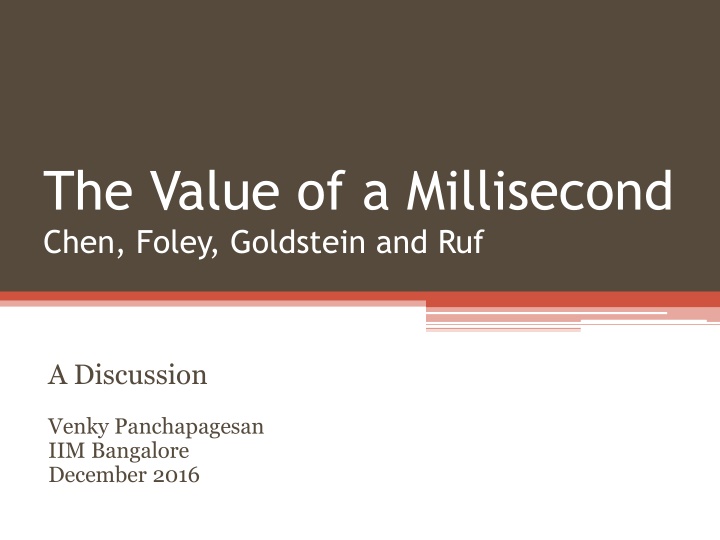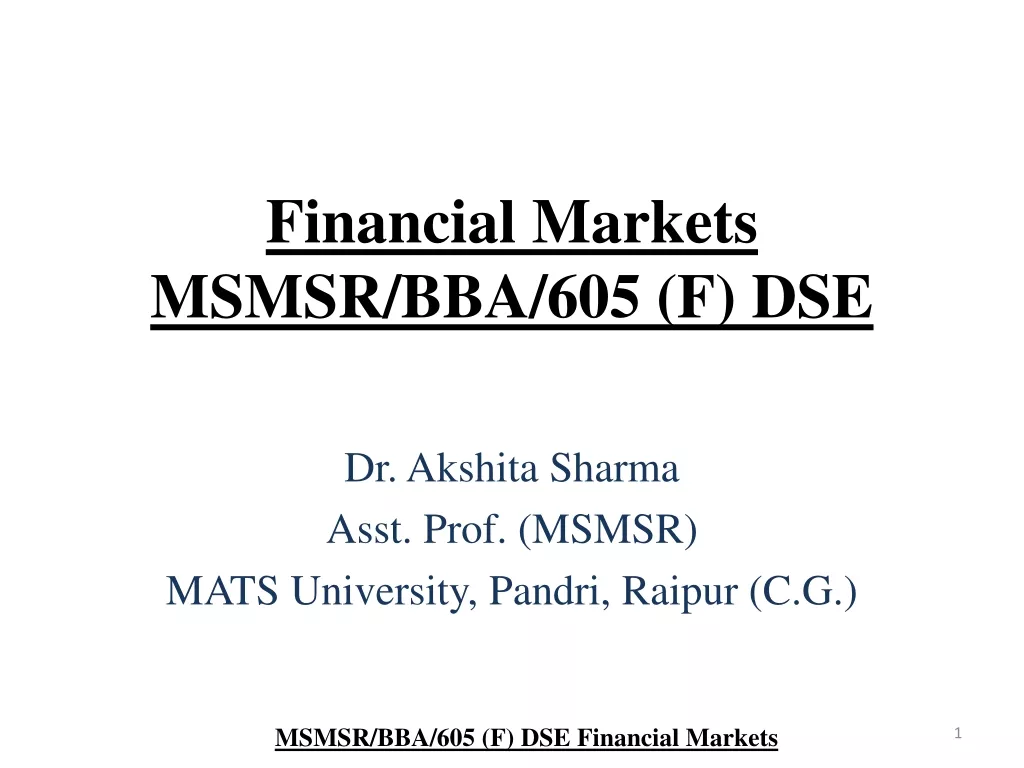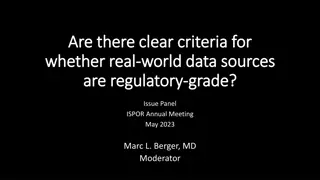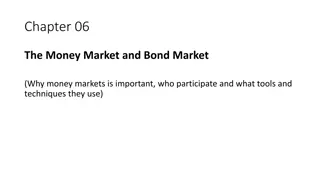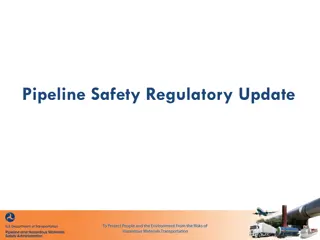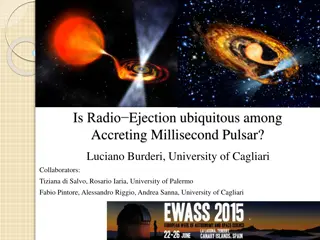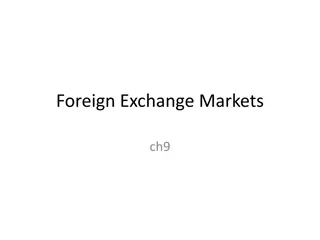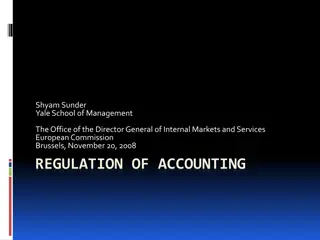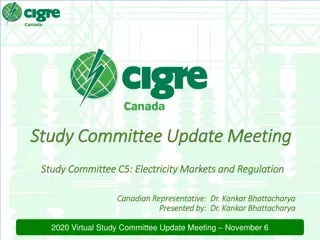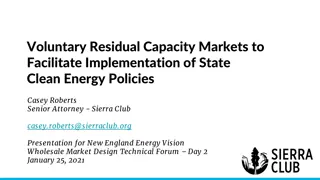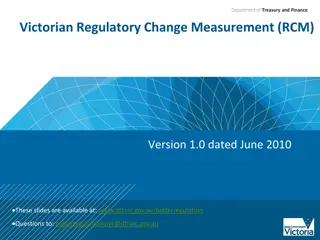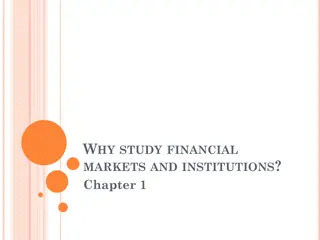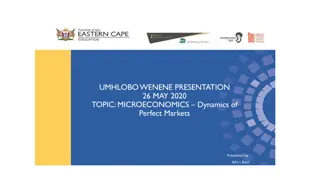The Value of a Millisecond: Assessing Regulatory Interventions in Financial Markets
The discussion explores the challenges in evaluating regulatory interventions due to overlapping issues and externalities. Authors utilize innovative methodologies to study the impact of speed bumps on trading activities. The assessment highlights the discriminatory nature of speed bumps and their significant externality effects on other markets. A comparison with other models sheds light on the implications for traders in different scenarios.
Download Presentation

Please find below an Image/Link to download the presentation.
The content on the website is provided AS IS for your information and personal use only. It may not be sold, licensed, or shared on other websites without obtaining consent from the author.If you encounter any issues during the download, it is possible that the publisher has removed the file from their server.
You are allowed to download the files provided on this website for personal or commercial use, subject to the condition that they are used lawfully. All files are the property of their respective owners.
The content on the website is provided AS IS for your information and personal use only. It may not be sold, licensed, or shared on other websites without obtaining consent from the author.
E N D
Presentation Transcript
The Value of a Millisecond Chen, Foley, Goldstein and Ruf A Discussion Venky Panchapagesan IIM Bangalore December 2016
2 Key Contribution Important to assess regulatory interventions using data Difficult to do well controlled assessments because of overlapping issues Difficult to assess identify and quantify externalities Authors make a very good attempt to do both with great data and creative methodology Clubbing trades to create trade chains to overcome timestamp issues Comparing with CX2 to tease out effects of speed bump keeping inverted pricing model constant
3 Overall Assessment Creating discriminatory speed bumps favors one set of traders over others Significant externality effects on other markets that don t follow Difficult to justify continuing such interventions
4 Big Picture Market Share
5 Big Picture Quote Fade
6 A Diligent Investor s Perspective Diligent investor one who delegates trading decision to brokers but monitors their performance; so investor-broker incentives are likely to be aligned Pre-change: All markets provide price protection; so I use SOR to sweep market Majority of my trades get done in TSX I will seek to avoid markets where pinging is prevalent (pinging > dark venues, cancellation fees are low etc.) Post-change: I find Alpha less attractive No price protection Random speed delay for market/marketable orders I disconnect Alpha from my SOR algorithm Maker/Taker pricing model does not matter much because I negotiate my commission rates accordingly (large investors estimate maker/taker fees earned by brokers by using execution data)
7 A Non-Diligent Investor s Perspective Non-diligent investor one who delegates trading decision to brokers but does not monitor their performance; so investor- broker incentives are less likely to be aligned Pre-change: All markets provide price protection; so I use SOR to sweep market for my client orders Majority of my client trades get done in TSX Will seek to preference markets where I get additional fees that I don t need to pass on to clients (without breaking my fiduciary responsibility) Post-change: I find Alpha greatly attractive Harder to establish fiduciary responsibility as there is no price protection Can afford to absorb speed delay for my marketable orders I use Alpha as my starting destination Maker/Taker pricing model matters much because I earn fees that I do not have to pass on to clients
8 A HFT Investor s Perspective Pre-change: All markets provide price protection; so I don t worry where I post Majority of my trades get done in TSX Will seek to preference markets where I get faster access and lower costs Post-change: I find Alpha greatly attractive Greater chance of interacting with stale orders waiting in the queue Likely to compete by posting orders aggressively at the last instant only under favorable conditions Other times I don t post aggressively I use Alpha as my selective destination Maker/Taker pricing model matters much because I need to trade off maker fees against posting orders to avoid speed bumps.
9 Open Questions Will Alpha survive in the long run? Who is sending market/marketable orders to Alpha post-change? Brokers controlling retail order flow? Why? What happens to the fiduciary responsibility of brokers when price protection is not guaranteed in one market? Should speed bumps be mandated by regulators for all markets as opposed to having markets compete? Should regulators intervene to protect retail investors?
10 Other Comments Interpretation Increase in quote fading since posting orders are not subject to speed delay Trade strings are computed by clubbing trades within 30 ms. But speed delay is only for 1-3 ms. Quote fading to avoid institutional SOR sprays SOR is less likely to use Alpha in the mix Informed trading definition Market resiliency is affected by speed bump rule; so quotes are more likely to stay moved after a trade Empirics that were missed out More price improving orders post-change Time between posting and trading should have come down for limit orders post-change Use of 1-min volatility measures (about 2000 trade strings) Were these Canadian shares traded in the US markets as well as ordinaries?
